5 easy ways to control algae in goldfish tank

Algae can quickly become a nuisance in goldfish tanks, turning your beautiful aquarium into a green mess. Fortunately, there are several effective methods to control algae without harming your goldfish. In this guide, we’ll explore five easy ways to keep algae in check and maintain a clean, healthy environment for your goldfish while answering the question: Can algae eaters live with goldfish?
The Nitrogen Cycle and possible harm to goldfish
To gain a comprehensive understanding of the nitrogen cycle’s implications for goldfish tanks, it’s essential to delve deeply into an analysis of the nitrogen cycle itself.
The Nitrogen Cycle in Goldfish Tank
In your goldfish tank, the nitrogen cycle is a crucial biological process that maintains a healthy aquatic environment for fish and other inhabitants. This process consists of three main stages: ammonia, nitrite, and nitrate.
Stages of the nitrogen cycle:
- Ammonia (NH3/NH4+):
- Process: The first step of the nitrogen cycle is the production of ammonia. Ammonia is typically generated from fish waste and neaten food particles. In water, it can exist in two forms: unionized ammonia (NH₃) and ionized ammonia (NH₄⁺), depending on the water pH.
- Impact: Unionized ammonia (NH₃) is more toxic. It can harm fish and other aquatic organisms, particularly causing damage to fish gills, leading to respiratory distress. Symptoms include gasping at the water surface, lethargy, and reddened gills.
- Nitrite (NO2-):
- Process: After ammonia is produced, beneficial bacteria like Nitrosomonas convert it into nitrite (NO₂⁻), which is also toxic but generally less harmful than ammonia.
- Impact: High levels of nitrite can be toxic to fish, causing damage to their respiratory system and internal organs. Symptoms of nitrite poisoning may include difficulty breathing, gasping for air, and lethargy.
- Nitrate (NO3-):
- Conversion: After nitrite is produced from ammonia, beneficial bacteria like Nitrobacter continue the conversion process by turning nitrite into nitrate (NO₃⁻). Nitrate represents the final oxidized form of nitrogen in this cycle.
- Impact: While nitrates are less toxic than ammonia and nitrites, high levels can still cause stress, inhibit growth, and reduce the fish’s ability to fight off diseases. Long-term exposure can lead to chronic health problems.
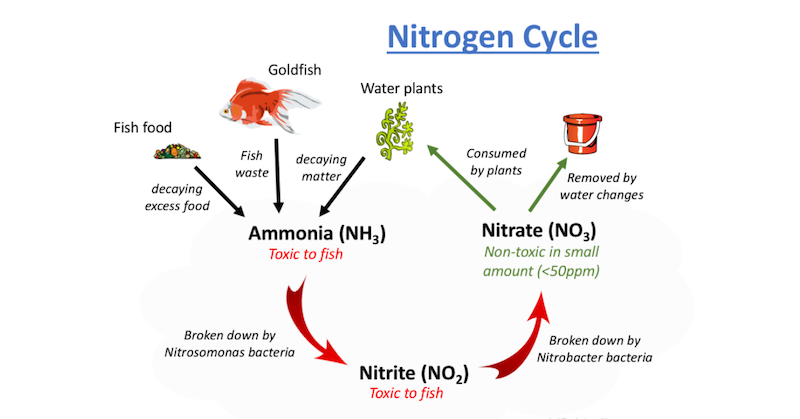
Role of algae in the nitrogen cycle
Algae plays a crucial role in the nitrogen cycle by consuming nitrate and other nutrients from the water column. This helps to reduce nitrate levels and nutrient load, providing oxygen and food for fish and other aquatic life. However, excessive nutrients can lead to algae overgrowth and issues such as algae blooms, which can deplete oxygen levels and affect water clarity.
Aquarists often come up with various ways to control algae, such as adjusting lighting schedules, using chemicals like algicides and the most popular way is algae eaters, which are popular for their natural ability to manage algae growth in tanks. These fish can coexist with goldfish and play a vital role in nutrient processing within the aquarium ecosystem.
Possible harm to goldfish
The Nitrogen Cycle, while essential for maintaining aquatic ecosystems, can pose significant challenges to the health of goldfish in aquariums. Here are some harmful effects of the nitrogen cycle on goldfish.
| Issue | Description | Impact on Goldfish |
| Oxygen depletion |
A decrease in dissolved oxygen is critical for respiration; Algae use oxygen during photosynthesis in the day and continue to consume it at night, potentially lowering oxygen levels in the tank and impacting fish health. |
Stress, breathing difficulties, susceptibility to immune disorders. |
| Water quality degradation | Algae decomposition releases toxins like hydrogen sulfide and ammonia, leading to poor water quality. | Stress, and weakened immune systems. |
From the summary table above, we will delve deeper into the serious impacts of the nitrogen cycle on goldfish.
- Oxygen Depletion:
Oxygen depletion in water is a critical issue for goldfish because they rely on dissolved oxygen for respiration. When oxygen levels drop, goldfish can experience stress, and difficulty breathing, and become more susceptible to immune system disorders.
According to the 2021 research on The Role of Algae in Oxygen Regulation by Vadeboncoeur et al., algae can effectively regulate oxygen levels through photosynthesis during daylight hours. However, this capability diminishes significantly at night or in low light conditions, potentially leading to oxygen depletion in the aquarium and posing a threat to the health of goldfish.
- Water Quality Degradation
According to the 2023 study on Algae Decomposition by Hallegraeff et al., algae decomposition releases toxins such as hydrogen sulfide and ammonia, which degrade water quality and directly harm goldfish. Specifically, these toxins increase ammonia levels in the water, posing respiratory stress and weakening immune systems in goldfish.
5 easy ways to control algae in your goldfish tank
In maintaining a clean and healthy environment for your goldfish, controlling algae growth is essential. Here, we explore five straightforward methods to effectively manage algae in your goldfish tank, ensuring a balanced ecosystem and optimal fish health.
Add algae-eating fish
Benefits of adding algae-eating fish
Algae eaters can indeed live with goldfish, and adding them to your tank provides significant benefits.
- Reduces algae growth in the tank: Algae-eating fish automatically consume algae and organic matter, helping to maintain cleaner water and ecological balance.
- Saves time and effort in tank maintenance: Less frequent cleaning and glass scraping as these fish naturally clean surfaces and decorations.
- Improves water quality and fish health: Reduced algae help balance the ecosystem and enhance fish resilience, extending their lifespan.
Therefore, adding algae-eating fish to your goldfish tank is a beneficial and practical choice that contributes significantly to creating a healthier aquatic environment for your goldfish.
Algae-eating fish species that can live with goldfish
Algae-eating fish species such as Bristlenose Plecos, Amano Shrimp, and Nerite Snails are popular choices for cohabitating with goldfish in aquariums. These species are known for their peaceful temperament and suitability for freshwater environments. Below are the key characteristics of each species.
| Species |
Characteristics |
| Rubber-lipped Plecos |
|
| Bristlenose Plecos |
|
| Amano Shrimp |
|
| Nerite Snails |
|
In summary, each of these species possesses unique characteristics that allow them to coexist harmoniously with goldfish in aquariums. However, be cautious with certain algae eaters, such as the Chinese algae eater, as they may exhibit aggressive behavior towards goldfish. If you’re still undecided, consider these three types of fish.
Notes on adding algae-eating fish to your goldfish tank
Adding algae-eating fish to your goldfish tank offers several benefits. However, achieving a balanced and thriving aquatic ecosystem requires careful consideration of several key factors:
- Compatibility: Select algae-eating fish species that peacefully coexist with goldfish to minimize conflicts over food and space. Look for species with a peaceful temperament to avoid conflicts with goldfish, and select those that can live in cool water and neutral pH.
- Nutritional needs: Provide adequate nutrition for both the algae-eating fish and your goldfish to prevent conflicts over food resources. For example, essential foods for both species include algae wafers and natural foods like seaweed.
- Monitoring: Regularly monitor the health and behavior of both types of fish to detect any signs of stress, illness, or compatibility issues early on. This helps prevent potential conflicts and ensures a harmonious tank environment.
- Tank size: Consider the size of your tank and the space requirements of algae-eating fish. Ensure there is enough room for all fish to swim comfortably and establish territories without overcrowding.
- Maintenance: Although algae-eating fish help control algae, regular tank maintenance such as cleaning the substrate, changing water, and maintaining filtration systems is still necessary to ensure optimal water quality.
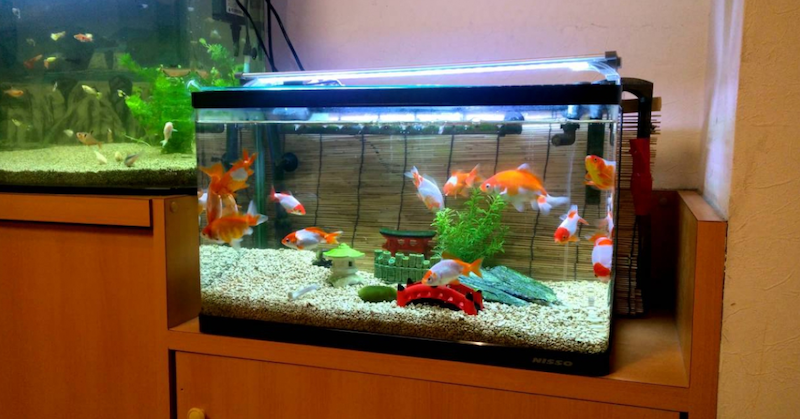
Regular tank maintenance
Regular maintenance helps control algae growth by removing excess nutrients, waste, and organic debris that algae thrive on. It also prevents the buildup of ammonia and nitrites, which can harm fish and promote algae growth. Maintaining a clean tank environment supports overall water quality, reduces stress on fish, and enhances the aesthetic appeal of the aquarium.
Cleaning frequency
- Cleaning the tank: It involves tasks such as scraping algae off the glass, removing debris from decorations, and vacuuming the substrate to remove waste and leftover food. This should be done every 1-2 weeks, depending on the algae growth and tank conditions.
- Water changes: Regular partial water changes are essential to dilute accumulated toxins like ammonia and nitrites. It also replenishes essential minerals and trace elements for fish health. Generally, changing 20-30% of the water every 1-2 weeks helps maintain water quality.
How to clean a goldfish tank?
Besides regular water changes, aquarium caretakers can follow these steps to clean goldfish tank:
- Cleaning algae: Clean algae off the glass and decorations to improve visibility and aesthetics. You can use a specialized algae scraper to avoid scratching the glass and a small brush for hard-to-reach areas.
- Cleaning the substrate: Vacuum the substrate to remove waste and uneaten food that can decay and contribute to algae growth.
- Maintaining filtration: Regularly clean and maintain the filter to ensure efficient removal of waste and maintenance of water parameters.
By adhering to a regular maintenance schedule that includes cleaning tasks and water changes, you can effectively manage algae growth and maintain a healthy environment for your goldfish.
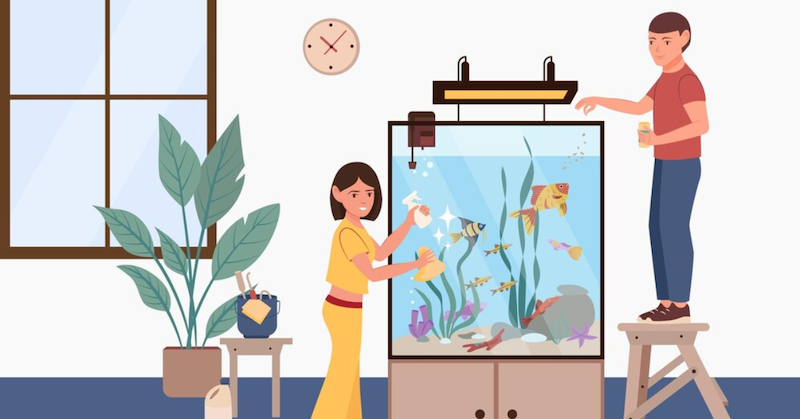
Control lighting
The relationship between light and algae control
Light plays a crucial role in controlling the growth of algae in aquatic environments. According to the 2015 research on the Effect of temperature and light on the growth of algae species by Satendra Pal Singh et al., it shows that controlling light can reduce the photosynthetic capability of algae, thereby decreasing the amount of algae growth in fish tanks.
Ideal lighting conditions for controlling algae growth
Here are two ways to create an ideal lighting environment to control algae growth in an aquarium:
- Place the tank in a low direct sunlight area: Position the aquarium in places with minimal exposure to direct sunlight. Direct sunlight can stimulate excessive algae growth due to abundant light energy. To mitigate this effect, place the tank in shaded areas or use curtains to block direct sunlight.
- Control lighting duration: Adjust the duration of aquarium lighting. Algae require light for photosynthesis and growth, but prolonged or excessive lighting can lead to overgrowth. Establish a suitable lighting schedule, typically around 8 to 10 hours per day for freshwater aquariums, adjusting as needed based on the specific needs of aquatic plants and fish in the tank.
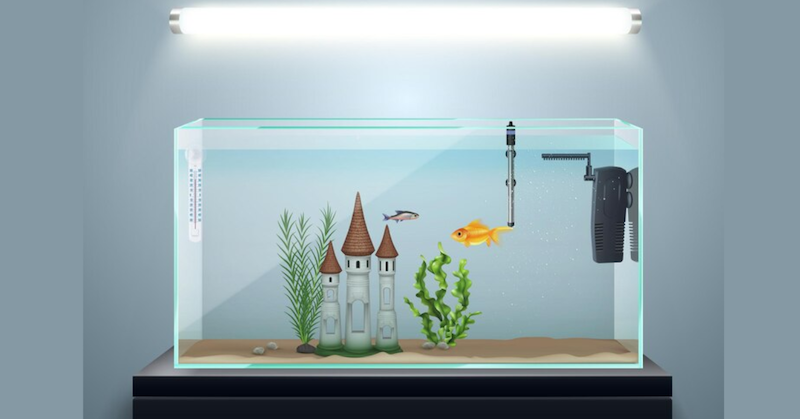
Types of light to use for algae control
The selection of lighting plays a crucial role in maintaining a balanced aquatic environment, particularly in controlling algae growth within aquariums. Here are the types of light aquarists should and should not use for controlling algae growth in aquariums.
| Type of Light | Recommended | Not Recommended |
| LED Lights | LED light intensity and spectrum can be adjusted, supporting aquatic plant growth without encouraging excessive algae growth. | |
| Fluorescent Lights | Emitting many green and red wavelengths, they are not easily adjustable for specific wavelengths and can stimulate excessive algae growth. | |
| Sunlight | Provides beneficial natural light for aquatic plants but can lead to excessive algae growth due to its strong intensity and difficulty to control. |
As highlighted in the above-mentioned study, using appropriate light and intensity is crucial for controlling algae. The study recommends utilizing LED lights, which can be adjusted to create optimal conditions for plants without promoting algae growth.
In conclusion, by choosing appropriate LED lights and avoiding fluorescent lights, along with managing natural sunlight exposure, aquarium caretakers can create a stable environment that supports the growth of aquatic plants without encouraging excessive algae growth.
Proper feeding practices
Overfeeding goldfish and impact on algae growth
Overfeeding fish is one of the primary causes of algae growth in aquariums. When the amount of food provided exceeds the fish’s consumption capacity, the leftover food settles at the bottom of the tank and begins to decompose. This decomposition process releases nutrients such as phosphates and nitrates into the water, creating an ideal environment for algae to thrive.
Additionally, fish waste also contributes to the increased nutrient levels in the water, further promoting algae proliferation. As a result, the aquarium becomes cloudy and ecologically imbalanced, affecting the health of the fish and other organisms in the tank.
Effective feeding methods for goldfish
To reduce excess food in a goldfish tank and maintain a clean and healthy environment, here are specific methods you can implement:
Recommended fish food
- Pellets or tablets: Choose food that is designed not to dissolve quickly in water. These pellets or tablets have a dense structure, preventing them from breaking down rapidly
- Live food such as daphnia or insects: Live foods like daphnia or insects provide natural nutrition and are consumed completely by the fish, reducing the risk of leftover food in the tank.
- Dried vegetables or seaweed: These options are suitable for those preferring a vegetarian diet for their fish. Dried vegetables or seaweed are nutritious and less likely to cloud the tank water.
Feeding practices
- Feeding time: Ensure that you feed the goldfish during the daytime when there is light so they can see and consume the food efficiently.
- Feeding frequency: Optimize feeding to once or twice a day. This helps ensure that the fish receive only the amount of food they need to maintain their health without generating excess food.
- Food portion: Feed small amounts each time, observing to ensure that all food is consumed within 2 to 3 minutes. Remove any uneaten food promptly to prevent water contamination and reduce the risk of algae growth.
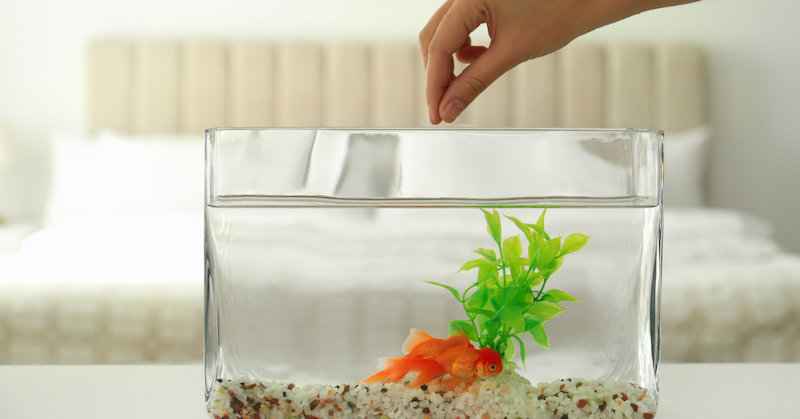
Aquatic plants
Benefits of aquatic plants
Aquatic plants aren’t just decorations in water environments; they play a vital ecological role by controlling algae growth and improving water quality for goldfish and other aquatic species.
- Algae control: Aquatic plants play a crucial role in regulating algae growth in fish tanks and other freshwater environments. A 2015 study on Aquatic plants in water by Li et al., found that aquatic plants can absorb nutrients and phosphates from water – which are the primary contributors to algae overgrowth. Additionally, aquatic plants can also absorb heavy metals, contributing to overall water quality improvement.
- For goldfish: A 2006 study on Aquatic plants published in Freshwater Biology revealed that underwater plants produce abundant oxygen, maintain a stable living environment, and increase beneficial bacterial populations for fish.
Types of Aquatic Plants to Use
Java Fern, Anubias, and Hornwort are excellent choices for planting in a goldfish tank, not only for their algae-controlling properties but also for their health benefits to goldfish. Let’s explore each type of plant:
Java Fern
Java Fern (Microsorum pteropus) is a popular aquatic plant in aquariums due to its high tolerance and easy care. Its sturdy leaves are resistant to erosion by goldfish, maintaining their lush green appearance over time. Additionally, Java Fern provides hiding places for goldfish, reducing stress and promoting their development.
Anubias
Anubias belongs to the Arum family (Araceae) and includes species like Anubias barteri and Anubias nana. This plant is well-suited for goldfish tanks because of its tough, algae-resistant leaves. Anubias thrives under low to moderate light conditions, making it effective in algae control without altering water conditions significantly.
Hornwort
Hornwort (Ceratophyllum demersum) is renowned for its ability to absorb nutrients from water, effectively cleaning it and preventing algae growth. With its dense, branching foliage, Hornwort provides excellent hiding spaces for goldfish and other fish species. Moreover, it can thrive under varying light intensities, making it a versatile choice for goldfish tanks.
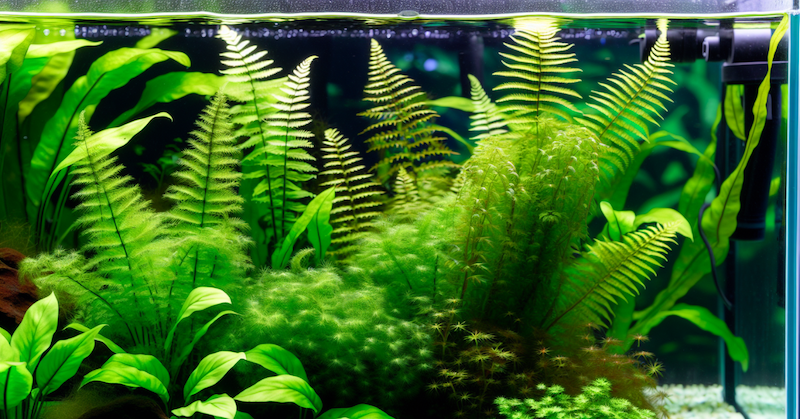
The Bottom Line
Through this article, we’ve explored five effective ways to control algae in your goldfish tank, promoting a healthier environment where both algae eaters and goldfish can thrive harmoniously. This discussion also confirms that algae eaters can live with goldfish, ensuring a balanced ecosystem and cleaner tank conditions.



